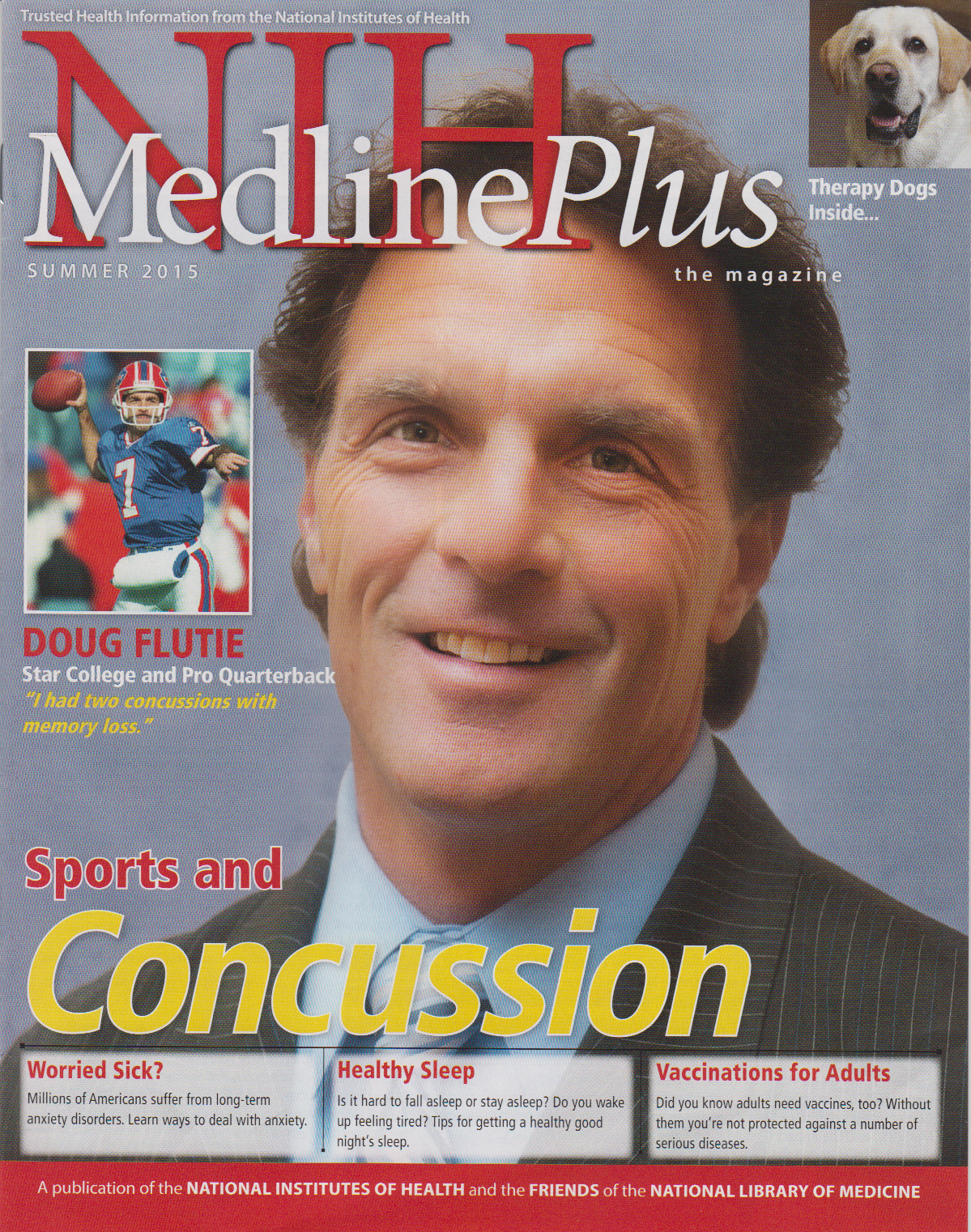
To Your Health: NLM update Transcript
NIH MedlinePlus Magazine Summer 2015: 08/31/2015

Greetings from the National Library of Medicine and MedlinePlus.gov
Regards to all our listeners!
I'm Rob Logan, Ph.D., senior staff, U.S. National Library of Medicine.
Here is what's new this week in To Your Health, a consumer health oriented podcast from NLM, that helps you use MedlinePlus to follow up on weekly topics.
The new edition of NIH MedlinePlus magazine covers anxiety, sleep disorders, as well as concussions and brain injuries.
The cover features ex-quarterback and current football broadcaster Doug Flutie, who explains he experienced one game-related concussion at Boston College and another with the San Diego Chargers. Flutie notes he continued to play after the concussion at Boston College but does not remember the rest of the game.
Flutie notes players and coaches are not the best judge of whether an athlete should return to the field after a head injury. Flutie says (and we quote): 'I believe it's up to the training staff to pull the player off the field,' (end of quote).
NIH MedlinePlus magazine notes about 1.4 million Americans suffer a traumatic brain injury annually from concussions and other sources. In other words, concussions and head injury risks are not exclusive to contact sport participants. NIH MedlinePlus magazine notes some everyday prevention for traumatic brain injuries include avoiding falling by using or installing:
- A step-stool with a grab bar to reach for high objects
- Handrails on staircases
- Window guards to protect toddlers
- Safety gates at the top and bottom of stairs for young children.
NIH MedlinePlus magazine reports falls are the cause of about 29 percent of all traumatic brain injuries. Motor vehicle accidents account for 20 percent of all traumatic brain injuries, while 19 percent are caused by a head strike from an object, and 10 percent result from a personal assault.
In a separate section, NIH MedlinePlus magazine highlights the symptoms, causes, and prevention of sleep disorders. NIH MedlinePlus magazine explains about 30 percent of American adults do not get enough sleep. The consequences of the latter include an estimated 1,500 deaths and 40,000 nonfatal injuries reported annually from drowsy driving.
NIH MedlinePlus magazine provides some tips to sleep better including: avoiding naps after 3 pm; sticking to a sleep schedule; and trying to avoid lying in bed while awake.
NIH MedlinePlus magazine adds current sleep research includes efforts to:
- better understand how sleep loss increases the risk of obesity, diabetes, heart disease, and stroke
- assess the genetic, environmental and social factors that lead to sleep disorders.
NIH MedlinePlus magazine also provides a special section about persons who are worried sick, or have adult anxiety disorders. NIH MedlinePlus magazine reports anxiety disorders are one of the most common reasons U.S. adults visit a primary healthcare provider.
NIH MedlinePlus magazine adds the three major types of anxiety disorders are called: generalized anxiety disorder; panic disorder; and social anxiety disorder. NIH MedlinePlus magazine explains all three are treatable by physicians, who often initially screen for a variety of underlying conditions (such as depression) that are associated with anxiety disorders.
NIH MedlinePlus magazine notes common anxiety disorder treatments include medications, and/or specific types of psychotherapy.
Other articles in the current NIH MedlinePlus magazine include: tips on adult vaccination as well as a tribute from NIH's director Francis Collins M.D. to NLM's recently retired director Donald A.B. Lindberg M.D.
As always, NIH MedlinePlus magazine provides a helpful list of phone numbers (many of them a free call) to contact NIH's array of institutes and centers.
NIH MedlinePlus magazine is distributed to physicians' offices nationwide by the U.S. National Institutes of Health and the Friends of the National Library of Medicine. You can subscribe or find the latest edition online by clicking on 'Magazine,' which is on the bottom right side of MedlinePlus.gov's home page.
Previous editions of NIH MedlinePlus magazine are available at the same site. A link to NIH MedlinePlus Salud, which provides other health information and resources in Spanish, is available there as well (see the top right of the page). The web version of NIH MedlinePlus magazine includes links that visually supplement the information in some articles.
Before I go, this reminder... MedlinePlus.gov is authoritative. It's free. We do not accept advertising .... and is written to help you.
To find MedlinePlus.gov, just type 'MedlinePlus.gov' in any web browser, such as Firefox, Safari, Chrome, or Explorer.
We encourage you to use MedlinePlus and please recommend it to your friends. MedlinePlus is available in English and Spanish. Some medical information is available in 43 other languages.
Your comments about this or any of our podcasts are always welcome. We welcome suggestions about future topics too!
Please email the podcast staff anytime at: NLMDirector@nlm.nih.gov
A written transcript of recent podcasts is available by typing 'Director's comments' in the search box on MedlinePlus.gov's home page.
The National Library of Medicine is one of 27 institutes and centers within the National Institutes of Health. The National Institutes of Health is part of the U.S. Department of Health and Human Services.
A disclaimer — the information presented in this program should not replace the medical advice of your physician. You should not use this information to diagnose or treat any disease without first consulting with your physician or other health care provider.
It was nice to be with you. Please join us here next week and here's to your health!





















.png)












No hay comentarios:
Publicar un comentario